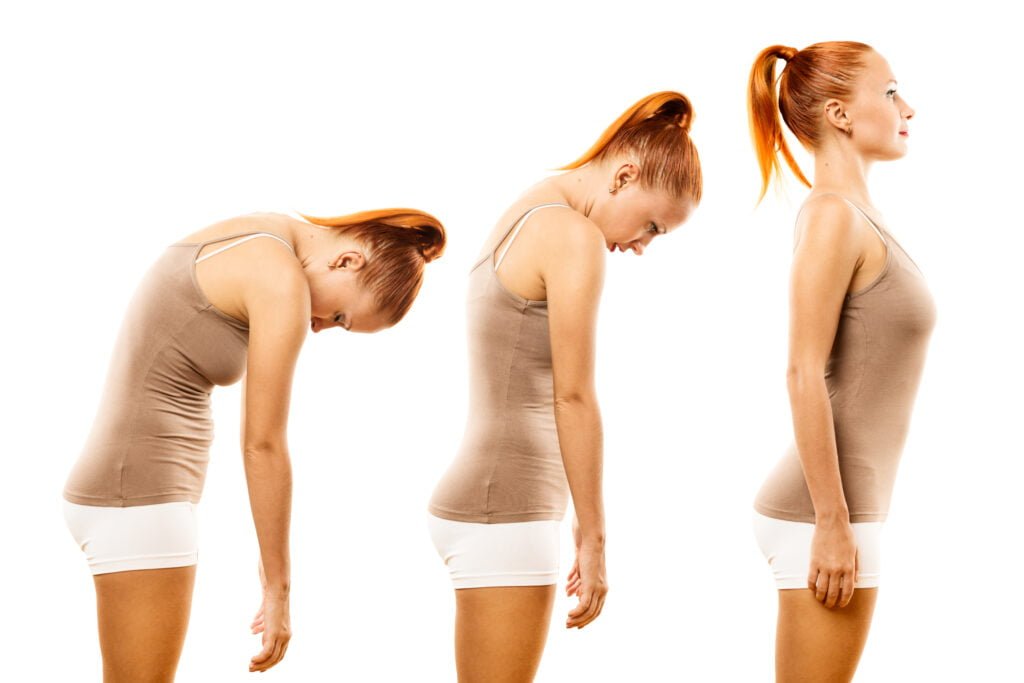
1. FORWARD HEAD POSTURE
The National Academy of Sports Medicine (NASM) defines FHP as holding the head out, in front of its natural position over the cervical spine. A person with FHP also typically tilts their head back in order to look forward.
This posture puts a strain on the muscles and bones of the neck. It can also lead to muscle imbalances, as some muscles support more of the load than others. The forward position of the head puts increasing amounts of weight pressure on the spine.
The muscles that FHP weakens and lengthens include:
- deep neck flexors, including the longus capitis and longus colli
- scapular stabilizers and retractors, such as the rhomboids, middle and lower trapezius, teres minor, and infraspinatus
The muscles that become shortened and overactive include:
- deep upper cervical extensors, such as the longissimus capitis, splenius capitis, cervical multifidus, and upper trapezius
- shoulder protractors and elevators, such as the pectoralis minor, pectoralis major, and levator scapula
Causes
People may associate FHP with using electronic devices for a long time, such as cell phones or computers.
However, any activity that causes a person to lean their head forward for a prolonged period of time can lead to chronic FHP.
Some potential causes of FHP include:
- slouching
- sleeping with the head raised
- carrying a heavy backpack or purse
- driving with a hunched back
- sewing
- reading in bed
- whiplash or other injuries to the spine
- weakness in the muscles of the upper back
- arthritis and bone degeneration
Side effects
There are several potential side effects and symptoms associated with FHP.
Pain and stiffness
The extra pressure on the neck muscles can cause increased strain and pressure. This in turn can cause pain and stiffness in the neck muscles.
People may experience:
- Anterior neck pain: The increased tension in the muscle above the hyoid bone can lead to neck pain or tightness at the front.
- Myofascial trigger points and headaches: FHP increases the load on the muscles in the upper cervical spine. This can cause cervicogenic headaches.
Rounded shoulders and upper back
FHP can cause a person to develop rounded shoulders and upper back.
Additionally, it can impact the movement patterns for the scapula, or shoulder blade, and the humerus, which is the long arm bone, resulting in a condition called scapular dyskinesis.
If a person experiences FHP and rounding of the shoulders, healthcare professionals refer to this as upper crossed syndrome.
RESPIRATORY ISSUES
FHP can cause the upper chest to expand while the lower chest contracts. This change in shape can interfere with regular breathing.
Treatment
A doctor may recommend physical therapy.
There are several potential treatments that a person can try at home, along with medical interventions. A person who works using a computer or other devices can practice sitting upright and keeping their neck in a neutral spine position. This means ensuring that the ears are in line with the shoulders.
Poor posture can lead to postural kyphosis. If this is severe, doctors may recommend surgical intervention.
In some cases, a person may find that pain medications may be helpful in reducing pain. A person may want to speak with their doctor about muscle relaxants or prescription-strength medications for severe pain.
ANRC Phases of Rehabilitation
Phase 1- Pain Relief (Trigger Point Therapy, Myofascial Release, Taping, Electrotherapy modalities(ultrasound, tens, IFT), breathing exercises, Basic Home exercises, etc.
Phase 2- Restoration of Range of movement of the neck, postural correction by various types of stretching exercises to tighten muscles and strengthening for the weakened muscles, scapular setting exercises with the resistive band, chin tucking exercises to improve the neck flexors strength along with breathing exercise.
Phase 3- Maintenance Phase & Improve the activity of daily living (Intensive Strength Training, Ergonomic Modifications in workplaces & Daily Activities), finally concentrating on the core strengthening exercises to make u all fit far better than before, proper advising to the clients about what to do and how to do for further prevention.
And from ANRC REHABILITATION CENTRE HORSHAM here we are listing some of the preventive measures that u all can do easily with your daily activities.
FOR FURTHER INFORMATION see your local Physiotherapist.
Click here to find your closest ANRC Physio clinic
FOR MORE INFORMATION see your local Physio Practitioner.
Quick Contacts
- Phone : +44 7483 807551
- Email : info@anrc-uk.com
- Locations : Horsham, East Grinstead, Ashurstwood, Lingfield
- Country : United Kingdom










